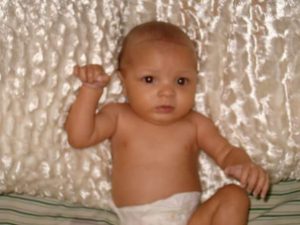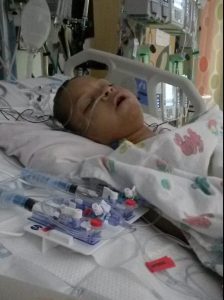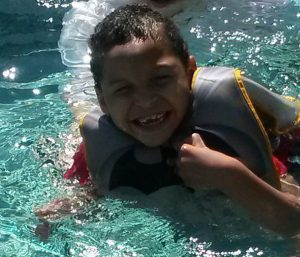
Only a week after giving birth to twins, a girl and a boy, in July of 2008, Annette Cole’s world was turned upside down. Something was wrong with her baby boy, Trevor Clemons. In his first couple weeks of life he was lethargic, irritable and couldn’t keep any food down. She was overwhelmed with fear as doctors delivered the difficult news.
The diagnosis felt as unreal as the name of the disease sounded: maple syrup urine disease (MSUD).
“We couldn’t believe it,” said Cole. “When we first found out about the disease, we had never heard of it before. We didn’t know what to expect. We didn’t know anything.”
MSUD is a rare genetic disorder. Babies with MSUD are missing an enzyme needed to process three amino acids that are essential for the body’s normal growth. MSUD, aptly named because it causes urine to smell like maple syrup, affects only about 1 in 185,000 babies.
“Maple syrup urine disease shows up quickly after birth,” said Dr. Patrick Healey, chief of transplantation at Seattle Children’s. “One of the most important nutrients needed is protein because it plays a crucial role in a child’s growth and function. Children with MSUD have a problem breaking down certain proteins and amino acids, which causes toxicity to build up in the body and affects a child’s developing brain. If not detected and treated early on in life, the disorder can be life-threatening and can cause mental and physical disabilities.”
Finding treatment
Trevor spent the first few years of his life in and out of hospitals, first in Atlanta, but after multiple complications the family decided to seek care from a specialist in Pittsburgh. Unfortunately, Trevor didn’t respond well to the traditional dietary treatments. As a next step, doctors in Pittsburgh recommended a liver transplant and he was added to the transplant list.
“Most families who have children with MSUD will face the question of whether or not to transplant at some point,” said Healey. “Generally, the disease is not life-threatening if it’s able to be managed with dietary restrictions, but a transplant can help to improve a child’s quality of life.”
Once Trevor was listed for transplant, the wait for a new liver began. The family waited, and waited. Almost four years went by and they never got a call.
Going the distance for care
After the long wait, the family decided to look for other options. They called Seattle Children’s Hospital.
“I’d go to the end of the earth to find the best treatment for my son,” said Cole.
Seattle Children’s transplant doctors are among the most experienced pediatric liver transplant surgeons in the U.S. and are global leaders in improving care for children before, during and after transplant.
“We chose Seattle Children’s for a lot of reasons,” said Cole. “We wanted a center that had experience with MSUD, that was willing and able to do the surgery and had good outcomes. Seattle checked all those boxes, but it wasn’t until we came to Washington and met the team in person that we were sold and knew this would be the place Trevor would get a liver. We felt as if our son wasn’t just a number or statistic. We felt important and as if we were in the right place.”
Outcomes of patients who receive liver transplants at Seattle Children’s are among the best in the nation, and the transplant program is one of six centers in the country to offer transplantation for children with MSUD.
“Seattle Children’s liver transplant program has an international reputation,” said Healey. “Children in need of transplants should go to a center with multidisciplinary expertise in metabolic conditions and solid clinical outcomes. We have both. We have a team that’s skilled in not only performing the transplant, but also in taking care of the patient after the procedure and getting them back to their life.”
New liver, new life

Two months after getting on the transplant list, Cole received the call she and her family had been waiting for: doctors had a liver for Trevor.
“When we first got the call it was scary, exciting and surreal,” said Cole. “It was everything! After waiting for so long we didn’t know if it would ever happen. And then it did.”
On Thanksgiving Day 2015, Trevor went into surgery and came out with a new liver – a gift his family will always be thankful for.
They are also thankful to Healey for being so attentive throughout the process.
“Dr. Healey was so great,” said Cole. “At 4 a.m. in the morning on Thanksgiving Day, he came out and shook my hand after the transplant. He said it was a success and everything went great. After a couple hours, Dr. Healey came back to check-in. He showed how much he cared about us and Trevor. He’s a great man. He’s a gift to children’s medicine.”
Trevor stayed inpatient for a couple weeks to recover after the transplant, but everything went smoothly.
“After the transplant it was like a fog had been lifted,” said Cole. “He was a whole new Trevor – new and improved.”
Enjoying the flavors of life
 Today, Trevor is 7 years old. He’s developmentally delayed due to the disease, but he enjoys swimming, dancing and playing with trucks and cars. Because of the liver transplant, he can now enjoy food without any restrictions. He enjoys trying new flavors and loves ravioli, fish, pasta and candy.
Today, Trevor is 7 years old. He’s developmentally delayed due to the disease, but he enjoys swimming, dancing and playing with trucks and cars. Because of the liver transplant, he can now enjoy food without any restrictions. He enjoys trying new flavors and loves ravioli, fish, pasta and candy.
“It’s incredibly rewarding to see kids go from being sick to being able to return to normal life, grow up and be themselves,” said Healey. “It’s why we do what we do. Trevor can now go to school and eat a normal lunch just like anyone else.”
In looking back on Trevor’s journey, Cole is forever grateful to the donor who changed her son’s life. She also has some words of advice for other families with children who have MSUD.
“My advice to other families is to never give up,” said Cole. “Never lose hope and you can come out the other side.”

